

Hyena-baiting is a blood sport involving the baiting of hyenas against dogs.


Hyena-baiting is a blood sport involving the baiting of hyenas against dogs.
The striped hyena has historically been the most frequently used species. Hyenas can be challenging opponents for dogs, as their jaws are exceedingly powerful. A single bite from a hyena lasting a few seconds without holding on is sufficient to kill a large dog. [1] Hyenas apparently fight dogs by trying to cripple them by biting at their legs. [2]
The Qalandar and the Thori in southern Punjab, Kandahar and Quetta, catch striped hyenas in order to pit them against specially trained dogs. The hyenas are restrained with ropes in order to pull them away from the dogs if necessary. [3] In Baluchistan, captured hyenas sometimes had bridles placed in their mouths in order to prevent them from injuring the dogs. This was done in order to train the dogs into not fearing the animal. [3] It is known that a Dogue de Bordeaux bitch named Megre was pitted against hyenas in 1895, though the exact species was not identified. [4]

Hyenas or hyaenas are feliform carnivoran mammals belonging to the family Hyaenidae. With just four extant species, it is the fourth-smallest family in the order Carnivora and one of the smallest in the class Mammalia. Despite their low diversity, hyenas are unique and vital components of most African ecosystems.

Jackals are medium-sized canids native to Africa and Eurasia. While the word "jackal" has historically been used for many canines of the subtribe canina, in modern use it most commonly refers to three species: the closely related black-backed jackal and side-striped jackal of sub-Saharan Africa, and the golden jackal of south-central Europe and Asia. The African golden wolf was also formerly considered as a jackal.

The cephalic index or cranial index is a number obtained by taking the maximum width of the head of an organism, multiplying it by 100 and then dividing it by their maximum length. The index was once used to categorize human beings in the first half of the 20th century, but today it is used to categorize dogs and cats.
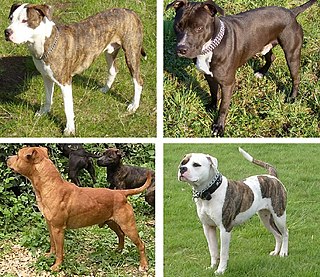
Pit bull is an umbrella term for several types of dog believed to have descended from bull and terriers. In the United states, the term is usually considered to include the American Pit Bull Terrier, American Staffordshire Terrier, American Bully, Staffordshire Bull Terrier, and sometimes the American Bulldog, along with any crossbred dog that shares certain physical characteristics with these breeds. In other countries, including the United Kingdom, the term is used as an abbreviation of the American Pit Bull Terrier breed specifically, while the Staffordshire Bull Terrier is not considered a pit bull. Most pit bull-type dogs descend from the British bull and terrier, a 19th-century dog-fighting type developed from crosses between the Old English Bulldog and the Old English Terrier.
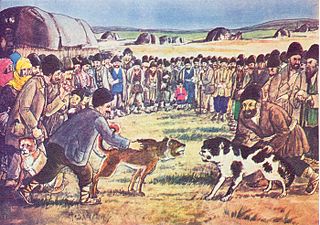
Dog fighting is a type of blood sport that turns game and fighting dogs against each other in a physical fight, often to the death, for the purposes of gambling or entertainment to the spectators. In rural areas, fights are often staged in barns or outdoor pits; in urban areas, fights are often staged in garages, basements, warehouses, alleyways, abandoned buildings, neighborhood playgrounds, or in the streets. Dog fights usually last until one dog is declared a winner, which occurs when one dog fails to scratch, dies, or jumps out of the pit. Sometimes dog fights end without declaring a winner; for instance, the dog's owner may call the fight.

The striped hyena is a species of hyena native to North and East Africa, the Middle East, the Caucasus, Central Asia, and the Indian subcontinent. It is the only extant species in the genus Hyaena. It is listed by the IUCN as near-threatened, as the global population is estimated to be under 10,000 mature individuals which continues to experience deliberate and incidental persecution along with a decrease in its prey base such that it may come close to meeting a continuing decline of 10% over the next three generations.

The brown hyena, also called strandwolf, is a species of hyena found in Namibia, Botswana, western and southern Zimbabwe, southern Mozambique and South Africa. It is the only extant species in the genus Parahyaena. It is currently the rarest species of hyena. The largest remaining brown hyena population is located in the southern Kalahari Desert and coastal areas in Southwest Africa. The global population of brown hyena is estimated by IUCN at a number between 4,000 and 10,000 and its conservation status is marked as near threatened in the IUCN Red List.

The spotted hyena, also known as the laughing hyena, is a hyena species, currently classed as the sole extant member of the genus Crocuta, native to sub-Saharan Africa. It is listed as being of least concern by the IUCN due to its widespread range and large numbers estimated between 27,000 and 47,000 individuals. The species is, however, experiencing declines outside of protected areas due to habitat loss and poaching. Populations of Crocuta, usually considered a subspecies of Crocuta crocuta, known as cave hyenas, roamed across Eurasia for at least one million years until the end of the Late Pleistocene. The spotted hyena is the largest extant member of the Hyaenidae, and is further physically distinguished from other species by its vaguely bear-like build, rounded ears, less prominent mane, spotted pelt, more dual-purposed dentition, fewer nipples, and the presence of a pseudo-penis in the female. It is the only placental mammalian species where females lack an external vaginal opening, having a pseudo-penis instead.
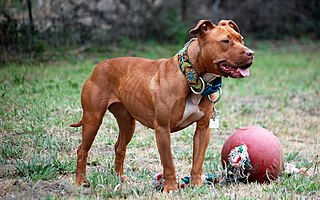
The American Pit Bull Terrier (APBT) is a dog breed recognized by the United Kennel Club (UKC) and the American Dog Breeders Association (ADBA), but not the American Kennel Club (AKC). It is a medium-sized, short-haired dog, of a solid build, whose early ancestors came from England. When compared with the English Staffordshire Bull Terrier, the American Pit Bull Terrier is larger by margins of 6–8 inches (15–20 cm) in height and 25–35 pounds (11–16 kg) in weight. The American Pit Bull Terrier varies in size: males are normally about 18–21 inches (45–53 cm) in height and around 35–60 pounds (15–27 kg) in weight, while females are normally around 17–20 inches (43–50 cm) in height and 30–50 pounds (13–22 kg) in weight.

The Dogue de Bordeaux, Bordeaux Mastiff, French Mastiff or Bordeauxdog is a large French mastiff breed. A typical brachycephalic mastiff breed, the Bordeaux is a very powerful dog, with a very muscular body.

Rat-baiting is a blood sport that involves releasing captured rats in an enclosed space with spectators betting on how long a dog, usually a terrier, takes to kill the rats. Often, two dogs competed, with the winner receiving a cash prize. It is now illegal in most countries.

Bull and terrier was a common name for crossbreeds between bulldogs and terriers in the early 1800s. Other names included half-and-halfs and half-breds. It was a time in history when, for thousands of years, dogs were classified by use or function, unlike the modern pets of today that were bred to be conformation show dogs and family pets. Bull and terrier crosses were originally bred to function as fighting dogs for bull- and bear-baiting, and other popular blood sports during the Victorian era. The sport of bull baiting required a dog with attributes such as tenacity and courage, a wide frame with heavy bone, and a muscular, protruding jaw. By crossing bulldogs with various terriers from Ireland and Great Britain, breeders introduced "gameness and agility" into the hybrid mix.

Animals in sport are a specific form of working animals. Many animals, at least in more commercial sports, are highly trained. Two of the most common animals in sport are horses and dogs.
A man-eater is an individual animal or being that preys on humans as a pattern of hunting behavior. This does not include the scavenging of corpses, a single attack born of opportunity or desperate hunger, or the incidental eating of a human that the animal has killed in self-defense. However, all three cases may habituate an animal to eating human flesh or to attacking humans, and may foster the development of man-eating behavior.
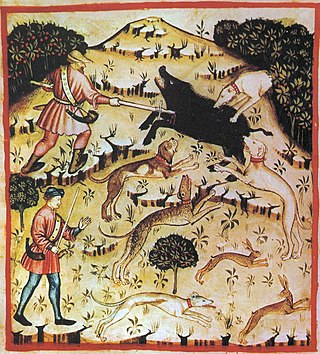
Boar hunting is the practice of hunting wild boar, feral pigs, warthogs, and peccaries. Boar hunting was historically a dangerous exercise due to the tusked animal's ambush tactics as well as its thick hide and dense bones rendering them difficult to kill with premodern weapons.

The rabies vaccine is a vaccine used to prevent rabies. There are several rabies vaccines available that are both safe and effective. Vaccinations must be administered prior to rabies virus exposure or within the latent period after exposure to prevent the disease. Transmission of rabies virus to humans typically occurs through a bite or scratch from an infectious animal, but exposure can occur through indirect contact with the saliva from an infectious individual.

Baiting is a blood sport where an animal is worried or tormented against another animal, for the purpose of entertainment or gambling. This activity is illegal in most countries with varying levels of enforcement.
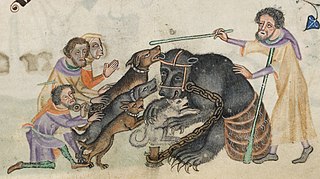
Bear-baiting is a blood sport in which a chained bear and one or more dogs are forced to fight one another. It may also involve pitting a bear against another animal. Until the 19th century, it was commonly performed in Great Britain, Sweden, India, Pakistan, and Mexico among others.

Wolf hunting with dogs is a method of wolf hunting which relies on the use of hunting dogs. While any dog, especially a hound used for hunting wolves may be loosely termed a "wolfhound", several dog breeds have been specifically bred for the purpose, some of which, such as the Irish Wolfhound, have the word in their breed name.

The spotted hyena has a long history of interaction with humanity; depictions of the species exist from the Upper Paleolithic period, with carvings and paintings from the Lascaux and Chauvet Caves. The species has a largely negative reputation in both Western culture and African folklore. In the former, the species is mostly regarded as ugly and cowardly, while in the latter, it is viewed as greedy, gluttonous, stupid, and foolish, yet powerful and potentially dangerous. The majority of Western perceptions on the species can be found in the writings of Aristotle and Pliny the Elder, though in relatively unjudgmental form. Explicit, negative judgments occur in the Physiologus, where the animal is depicted as a hermaphrodite and grave-robber. The IUCN's hyena specialist group identifies the spotted hyena's negative reputation as detrimental to the species' continued survival, both in captivity and the wild.